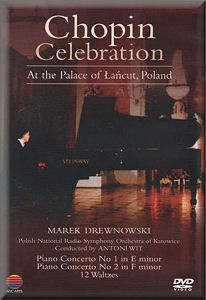 |
 |
|


alternatively
MDT
|
Chopin Celebration
Frédéric CHOPIN (1810-1849)
Piano concerto no.1 in E minor, op.11 (1830) [37:10]
Grande valse brillante, op.18 (1833) [4:42]
Grande valse brillante, op.34 no.1 (1835) [5:13]
Grande valse brillante, op.34 no.2 (1831) [5:37]
Grande valse brillante, op.34 no.3 (1838) [1:56]
Grande valse, op.42 (1840) [3:39]
Valse, op.64 no.1 (Minute waltz) (1846) [1:38]
Valse, op.64 no.2 (1846) [3:13]
Valse, op.64 no.3 (1847) [2:55]
Valse, op.69 no.1 (1835) [4:07]
Valse, op.69 no.2 (1829) [2:48]
Valse, op.70 no.1 (1832) [2:57]
Valse in E minor, op. posth. (1830) [2:35]
Piano concerto no.2 in F minor, op.21 (1830) [31:36]
 Marek Drewnowski (piano)
Marek Drewnowski (piano)
Polish National Radio Symphony Orchestra of Katowice/Antoni Wit
Directed by Ron Isted
rec. details not given
 NVC ARTS 5051865 710622 [112:20]
NVC ARTS 5051865 710622 [112:20] 

|
|
|
Visit the website
of Lańcut castle in the far south eastern corner of Poland
and you will find a link to “Records, documentaries and
feature films”. Unfortunately, that turns out to be something
of a misnomer, leading as it does to just a couple of old movie
clips, neither of which is more than a minute or so long. The
first, prefaced by a title-card that proclaims First short-of-cash
now full-of-jewels, seems to be part of an old silent movie
showing a thief escaping from (presumably) the castle, while
the second, looking like it dates from the 1930s, depicts a
group of bigwigs touring Lańcut and examining the estate’s
bloodstock. Thankfully, this new DVD will now allow the website
to show some rather more up to date material (even if it’s
still not absolutely contemporary - the small print on the box
indicates an original copyright date for this film of 1993.)
The purpose of the whole exercise is, though, otherwise rather
unclear.
From the fact that so much of the performance is overlaid by
images of the castle, its grounds and artefacts, it would seem
likely that this is primarily a marketing tool for purposes
of promoting tourism - and a product to stock in the castle
gift shop - rather than a film to showcase the artists.
That impression is only reinforced by the fact that so little
attention has been paid to the needs of the music itself. The
first thing that will strike you - as the camera gives us a
brief initial tour of the grounds and some of the castle’s
splendid interiors during the orchestral opening of the first
concerto - is the very resonant accoustic in which it is being
performed. Lańcut has an undeniably attractive appeal to
the eye but gives the ear real problems whenever the full resources
of the full symphony orchestra are deployed in one of its magnificent
salons. In fact, after a while I found it necessary to turn
the volume on my television down significantly in order to listen
more comfortably through the sonic soup. It is worth noting
that in the case of three of the waltzes for solo piano - op.64
nos 2 and 3 and op.69 no.1 - the sound, recorded in a small,
more intimate theatre within the castle, emerges much more successfully.
Polymath Marek Drewnowski, lauded on the box cover as a successful
“actor, film producer, music festival founder, music professor
and conductor”, invariably plays the notes well enough
and, unsurprisingly, sounds thoroughly idiomatic in this repertoire.
But, in the E minor concerto in particular, whenever he appears
on camera - as an increasingly welcome break from yet more shots
of the Columned Salon, the Sculpture Gallery or the Turkish
Apartment - he appears to be utterly emotionally detached from
the music and almost to be just going through the motions. That
is, though, perhaps an understandable response if you know that
your contribution is to supply long stretches of “background
music” to be played under images of old carriages, kitsch
Victorian sculpture, portraits of obscure and long forgotten
aristocrats and lots of clocks (the focus, naturally, of the
director’s attention during the performance of the Minute
waltz).
Conductor Antoni Wit is, on the other hand, a far more animated
presence and leads the orchestra with character, warmth and
distinction.
This is, then, probably a DVD for anyone who enjoys spending
an evening at their neighbours’ house looking at slide
shows of their latest holiday. Lovers of Chopin’s music
will, though, do just as well by putting on a CD of one of their
favourite performances and avoiding the distraction of those
darned clocks.
Rob Maynard
|
|

